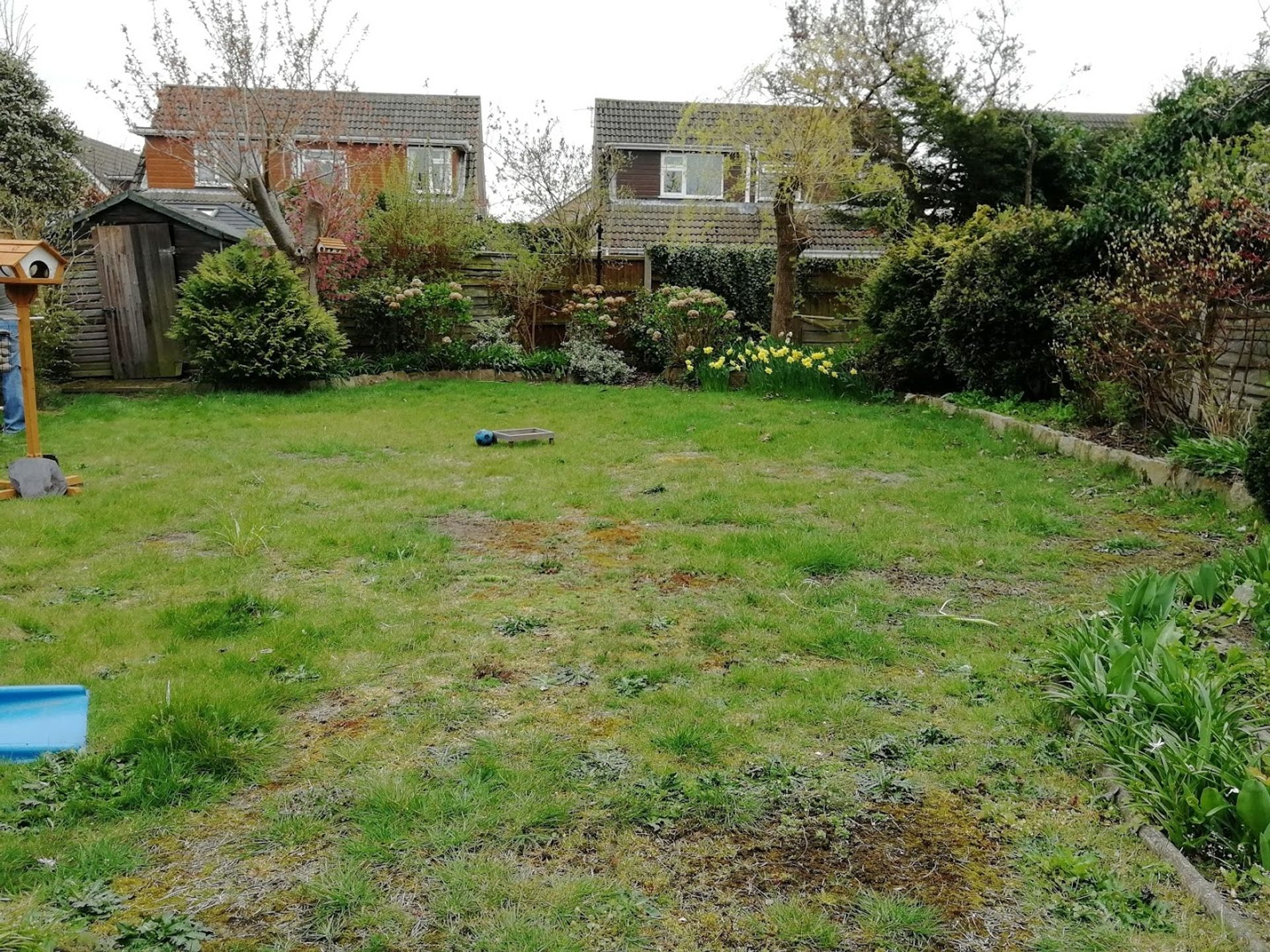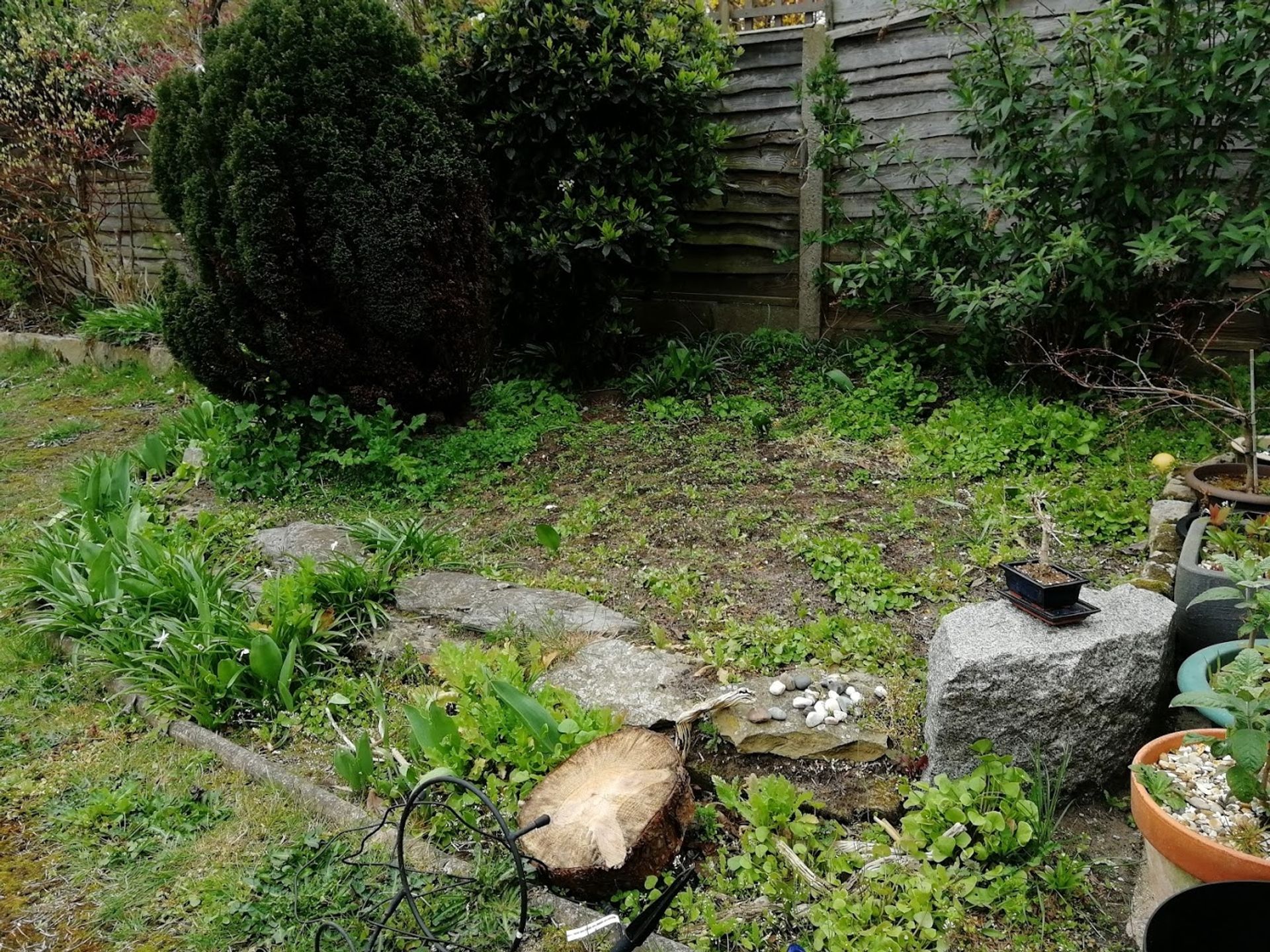We didn't really expect to find a house quite as soon as we did. When one showed up in our price range around the corner from my dad's house and my daughters' school, we obviously went and had a look at it. When it ticked the boxes of what we were looking for, we put in an offer. When it was accepted, we suddenly had a lot of planning to do.
We got the keys in October, and we obviously focused on the inside to get ourselves settled. The garden had obviously been left for a while with only the minimum upkeep on it, so the lawn wasn't in great condition and things were a little overgrown. However, we had absolutely no idea at all what was in the garden. I figured the sensible thing to do was to wait for a little while and try to identify what was in there as far as we could before we started making any changes.
To add a little more fun to things, we also hosted the family that christmas, and my family just happened to include a newly qualified garden designer and a professional gardener alongside my mother in law who simply loves gardening. I got a bit of help identifying some of the plants, some care tips, some problems spotted that I could address, and a joking description of the garden that stuck with me and still makes me laugh even now: It was a washing machine garden.
It basically means that, like in the vast majority of gardens, it's a big expanse of open lawn in the middle and planting beds all flung around the outside like a washing machine on a spin cycle. This is a pretty basic design, and the vast majority of houses you'll see will have something like this because it's just how gardens were done for a long, long time. If it's done well, it can still look really nice - particularly if you like having a vast expanse of lawn.

The washing machine garden it all it's glory
Personally, I share my mother-in-law's viewpoint that a lawn is a green desert. It serves little to no use for wildlife when cut short, and all it does it consume water. If you leave it long, that's slightly better but you'll also need to leave the weeds and wildflowers if you want to give the local wildlife a helping hand. But I digress.
The first time we really got outside to start investigating the garden was in the March, about six months after we'd moved in, and that's when that photo was taken. You can probably make out the state of the lawn - patchy and full of weeds. You can probably also see the shed in the corner, and a very slightly raised bed which runs around the perimeter of the garden with a few breaks here and there for access. There were also a few trees, including a rather raggedy specimen of a pear tree that's just out of shot that my wife was convinced was on its last legs, so we got in a tree person to take a look in case it needed to come down.
The pear was fine, we were told, and had years left in it even though it looked a bit rough. The cherry on the left has been hacked in a rather brutal manner at some point, but that was basically fine as well. However, the willow on the right was rotten through. That was a surprise, but when it was taken down we found that it had about an inch of solid wood in the foot-wide trunk. Lesson one - if a tree moves when you lean on it, that's not a good sign.
I thought we could move the shed to the opposite side where it could be tucked away in the corner, but when I made the attempt it basically fell down around me because it had mostly rotted away. I considered saving it, but I thought that the damage was too extensive and ended up just breaking it down.

Goodbye, shed. We hardly knew ye.
There were also a few other things that we knew we didn't want, or were too overgrown, and we appeared to have several million daffodils dominating the borders to the extent that anything else that might once have been alive in there had been swamped other than the shrubs. Taking stock, we also had something like seven mophead hydrangeas, four viburnums, a bunch of lilacs, three or four weigleias, four conifers that mostly blocked light to other plants, a border that wanted to eat up lots of space in the garden, and a little flagged area at the back of the house that really needed to be pushed out a bit further to be useful:

This border came about four metres into the garden and seemed to have two separate edges
So, even before we had a solid design for the garden in mind, I knew that I had to start taking things into hand before it got any harder. I didn't want to do anything too drastic before the garden had a chance to show me what it had in it, but equally there was a significant amount of remediation to do to get it back to a decent structural level.
First, I tackled the area denuded by the shed, and removed the conifer in front of it. It was actually flagged underneath, and that meant that with some tidying up, this area became somewhere that a couple of chairs and maybe a table could go to give another look back at the garden:

Plenty of space for a couple of chairs and some pots, and without the conifer you can see what's going on in the rest of the garden
We had to keep the girls occupied, so up went their slide and the trampoline, and then I cleared out the weeds in the overgrown flowerbed and over the course of a few weekends I pushed it back as far as was practical given the other planting in there that I didn't want to lose or risk moving - particularly the gorgeous acer. Throwing in a couple of extra flags conveniently left at the side of the house meant that I could extend the useful area of those flags a bit more, too. Incidentally, this was also when I discovered that my phone had a really good panoramic mode that let me take in the whole space in one photo:

You can see the recovered chunks of stone and the reduction in size of the border, plus some of the tidying up done in the garden borders (Original Size image)
Okay, so I'd basically starting by making a big mess, but I was starting to get a feel for the work involved, and started to adjust the layout slightly to what I thought would better suit our purposes. I had some idea of the functional elements that we wanted to include, and while the materials in there might not have been our first choice we could work with them. Sure, we'd much prefer a big, chunky raised bed made from sleepers, but our money really needed to go on the inside of the house rather than the outside. We already had (slightly) raised beds edged in stone, and I'd recovered a bunch more stone along the way from shifting the bed in a bit. I had free raw materials, so I might as well make use of those. After all, the main idea was to make something that met our needs, and what we had was good enough and still looked nice (and was arguably more natural-looking that sleepers would be). I could work with it, and I was starting to see the difference that my effort was making.
I had started.
Published
Last Post: Initial garden ideas
Next Post: Taking shape - but what shape?
How about sharing this article on your favorite social media network if you've found it interesting? For feedback, please get in touch via Twitter or Instagram